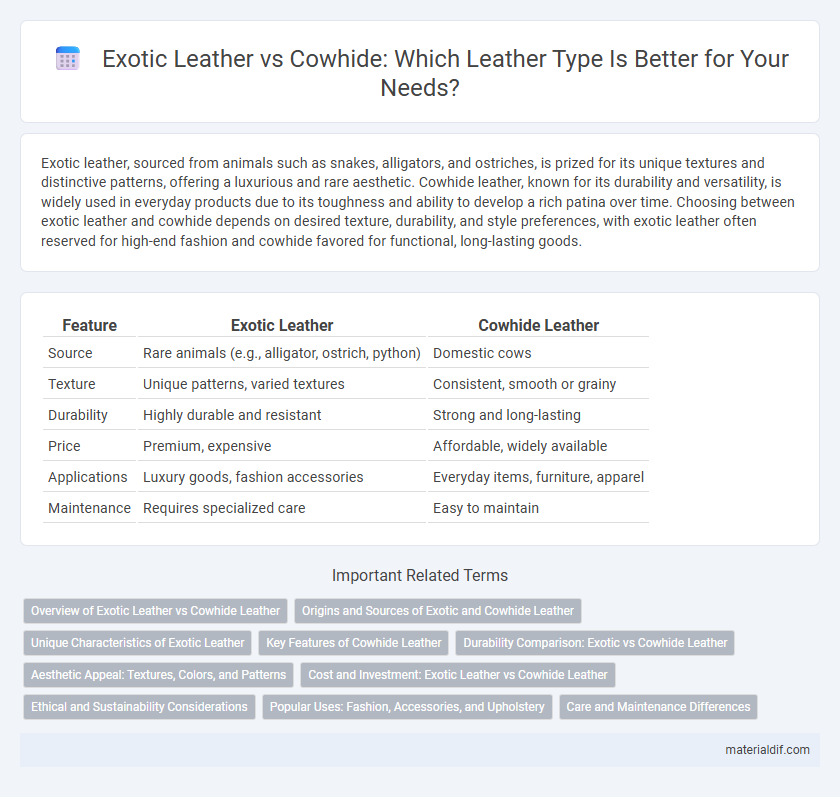Exotic leather, sourced from animals such as snakes, alligators, and ostriches, is prized for its unique textures and distinctive patterns, offering a luxurious and rare aesthetic. Cowhide leather, known for its durability and versatility, is widely used in everyday products due to its toughness and ability to develop a rich patina over time. Choosing between exotic leather and cowhide depends on desired texture, durability, and style preferences, with exotic leather often reserved for high-end fashion and cowhide favored for functional, long-lasting goods.
Table of Comparison
| Feature | Exotic Leather | Cowhide Leather |
|---|---|---|
| Source | Rare animals (e.g., alligator, ostrich, python) | Domestic cows |
| Texture | Unique patterns, varied textures | Consistent, smooth or grainy |
| Durability | Highly durable and resistant | Strong and long-lasting |
| Price | Premium, expensive | Affordable, widely available |
| Applications | Luxury goods, fashion accessories | Everyday items, furniture, apparel |
| Maintenance | Requires specialized care | Easy to maintain |
Overview of Exotic Leather vs Cowhide Leather
Exotic leather, sourced from animals like alligators, snakes, and ostriches, offers unique textures and patterns not found in cowhide leather, which is derived from cattle. Cowhide leather is known for its durability, versatility, and affordability, making it a popular choice for everyday items such as shoes, jackets, and furniture. Exotic leather tends to command higher prices due to its rarity, distinctive appearance, and the intricate tanning processes required for its preparation.
Origins and Sources of Exotic and Cowhide Leather
Exotic leather originates from rare animal species such as snakes, alligators, ostriches, and stingrays, often sourced from regulated farms or wild habitats to ensure sustainability and legal compliance. Cowhide leather is derived from domestic cattle, primarily sourced from slaughterhouses and byproducts of the meat industry, offering a more widely available and cost-effective option. The unique textures and durability of exotic leather contrast with the versatility and robustness of cowhide, reflecting their distinct origins and production methods.
Unique Characteristics of Exotic Leather
Exotic leather, sourced from animals like alligators, snakes, and ostriches, features distinctive textures and patterns that set it apart from traditional cowhide leather. Its rarity and intricate surface, often showcasing scales, quills, or unique grain, contribute to higher durability and luxury appeal. These unique characteristics make exotic leather highly sought after for premium fashion accessories and bespoke upholstery.
Key Features of Cowhide Leather
Cowhide leather is renowned for its durability, thickness, and natural grain patterns, making it a preferred choice for robust and long-lasting products. Its uniform texture and resistance to wear and tear provide excellent strength, ideal for furniture, footwear, and accessories. Cowhide's ability to develop a rich patina over time enhances its aesthetic appeal and signifies high-quality, everyday-use leather.
Durability Comparison: Exotic vs Cowhide Leather
Exotic leather such as alligator, ostrich, and snakeskin often offers superior durability due to its dense fiber structure and natural resistance to abrasion, making it highly suitable for luxury goods subject to frequent wear. Cowhide leather, while generally more affordable, provides sturdy durability with good tensile strength and flexibility, widely used in furniture, footwear, and accessories. The durability of exotic leather typically surpasses cowhide in specialized applications, but cowhide remains a reliable, tough option for everyday use.
Aesthetic Appeal: Textures, Colors, and Patterns
Exotic leather such as alligator, python, and ostrich offers unique textures with pronounced scales, ridges, and natural patterns that create visually striking and luxurious aesthetics. Cowhide leather provides a more uniform, smooth texture and a broader range of colors, often enhanced by tanning processes for versatility in fashion and upholstery. The distinct patterns in exotic leather are irreplaceable, making each piece a unique statement, whereas cowhide's consistent surface enables classic, timeless designs.
Cost and Investment: Exotic Leather vs Cowhide Leather
Exotic leather, sourced from animals like alligators, ostriches, or snakes, commands a significantly higher price than traditional cowhide leather due to its rarity, unique texture, and labor-intensive processing methods. Investing in exotic leather offers a potential for higher resale value and exclusivity, making it a preferred choice for luxury goods and long-term collection. Cowhide leather remains a cost-effective option with durable qualities suitable for everyday use but generally lacks the distinctive appeal and investment premium of exotic hides.
Ethical and Sustainability Considerations
Exotic leather, sourced from animals like alligators or snakes, often involves stricter regulations due to endangered species protection and raises concerns about biodiversity impact. Cowhide leather, primarily a byproduct of the meat industry, tends to have a lower ecological footprint when sourced from farms practicing sustainable livestock management and ethical animal welfare standards. Consumers seeking eco-friendly alternatives may prioritize cowhide leather certified by organizations such as the Leather Working Group, which promotes transparency and sustainability in leather production.
Popular Uses: Fashion, Accessories, and Upholstery
Exotic leather, derived from reptiles, ostrich, and alligators, is highly sought after for luxury fashion items such as handbags and footwear due to its unique texture and rarity. Cowhide leather remains the dominant choice for accessories and upholstery, favored for its durability, affordability, and versatility across jackets, belts, and furniture. Both materials serve specific market demands, with exotic leather emphasizing exclusivity and cowhide providing practical, everyday wear and home decor solutions.
Care and Maintenance Differences
Exotic leather, such as alligator or ostrich, requires specialized care involving gentle cleaning with specific conditioners to preserve its unique texture and prevent drying or cracking. Cowhide leather is more durable and easier to maintain, benefiting from regular cleaning and conditioning with standard leather care products to retain softness and prevent wear. Both types should be kept away from excessive moisture and direct sunlight, but exotic leathers need more cautious handling due to their delicate surface structure.
Exotic Leather vs Cowhide Leather Infographic

 materialdif.com
materialdif.com